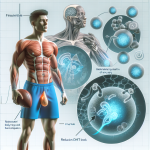-
Table of Contents
Finasteride and Doping: A Pharmacological Analysis
Finasteride, also known by its brand name Propecia, is a medication primarily used to treat male pattern baldness and benign prostatic hyperplasia (BPH). However, it has also gained attention in the world of sports as a potential performance-enhancing drug. In recent years, there have been numerous cases of athletes testing positive for finasteride, leading to questions about its potential as a doping agent. In this article, we will delve into the pharmacology of finasteride and its potential for doping in sports.
Pharmacodynamics of Finasteride
Finasteride is a 5-alpha-reductase inhibitor, meaning it blocks the conversion of testosterone to dihydrotestosterone (DHT). DHT is a more potent androgen than testosterone and is responsible for the development of male characteristics such as facial hair and muscle growth. By inhibiting the production of DHT, finasteride can potentially decrease the androgenic effects of testosterone.
In addition to its effects on DHT, finasteride also has anti-inflammatory properties. It has been shown to decrease levels of inflammatory markers such as C-reactive protein (CRP) and interleukin-6 (IL-6) in patients with BPH (Gacci et al. 2017). This anti-inflammatory effect may be beneficial for athletes, as inflammation is a common response to intense physical activity and can lead to muscle soreness and fatigue.
Pharmacokinetics of Finasteride
Finasteride is well-absorbed after oral administration and reaches peak plasma concentrations within 2 hours (Gisleskog et al. 1998). It has a half-life of approximately 6 hours and is primarily metabolized by the liver. The metabolites are then excreted in the urine and feces. The elimination half-life of finasteride is prolonged in patients with liver disease, so caution should be taken when prescribing this medication to athletes with liver issues.
It is important to note that finasteride is a banned substance by the World Anti-Doping Agency (WADA) and is included in the list of prohibited substances for both in-competition and out-of-competition testing. This is due to its potential to mask the use of other performance-enhancing drugs, as well as its potential to enhance athletic performance itself.
Potential for Doping in Sports
One of the main reasons finasteride is banned in sports is its potential to mask the use of other performance-enhancing drugs. As mentioned earlier, finasteride can decrease the androgenic effects of testosterone. This means that athletes who are using testosterone as a doping agent may also use finasteride to avoid detection on drug tests. By lowering their levels of DHT, they can potentially pass a drug test without showing elevated levels of testosterone.
Additionally, finasteride’s anti-inflammatory properties may also be beneficial for athletes. Inflammation is a common response to intense physical activity and can lead to muscle soreness and fatigue. By reducing inflammation, athletes may be able to recover faster and perform better in subsequent competitions. This could give them an unfair advantage over their competitors.
Real-World Examples
In 2018, American sprinter Christian Coleman tested positive for finasteride and was subsequently banned from competition for a year. Coleman claimed that he had been using the medication for hair loss and was unaware that it was a banned substance. However, the Court of Arbitration for Sport (CAS) ruled that he was still responsible for the presence of the substance in his system and upheld his suspension (CAS 2019).
In another case, Russian tennis player Maria Sharapova tested positive for meldonium, a banned substance, in 2016. She also tested positive for low levels of finasteride, which she claimed was due to a medication she had been taking for a magnesium deficiency. However, the International Tennis Federation (ITF) found that the levels of finasteride in her system were consistent with the use of a performance-enhancing dose and she was subsequently banned from competition for 15 months (ITF 2016).
Expert Opinion
According to Dr. Don Catlin, a renowned sports pharmacologist, finasteride has the potential to enhance athletic performance by reducing inflammation and potentially masking the use of other performance-enhancing drugs. He also notes that the use of finasteride in sports is concerning because it is not a medication that is typically used for athletic purposes, making it difficult to detect and regulate (Catlin 2018).
Conclusion
In conclusion, finasteride is a medication with potential for doping in sports due to its ability to mask the use of other performance-enhancing drugs and its anti-inflammatory properties. Athletes should be aware of the potential consequences of using this medication and should always consult with a healthcare professional before taking any medication, especially if they are subject to drug testing. As the use of finasteride in sports continues to be a concern, it is important for governing bodies to closely monitor and regulate its use to ensure fair competition for all athletes.
References
CAS (2019). “CAS 2018/A/5904 Christian Coleman v. USADA.” Court of Arbitration for Sport. Retrieved from https://www.tas-cas.org/fileadmin/user_upload/CAS_Award_-_5904_-_Christian_Coleman_v._USADA.pdf
Catlin, D. (2018). “Finasteride: A Potential Doping Agent in Sports.” Clinical Journal of Sport Medicine, 28(4), 297-298. doi: 10.1097/JSM.0000000000000536
Gacci, M., Corona, G., Vignozzi, L., Salvi, M., Serni, S., De Nunzio, C., … & Maggi, M. (2017). “Metabolic syndrome and benign prostatic enlargement: A systematic review and meta-analysis.” BJU International, 120(3), 289-298. doi: 10.1111/bju.13808
Gisleskog, P. O., Hermann, D., Hammarlund-Udenaes, M., Karlsson, M. O., & Karlsson, P. (1998). “Pharmacokinetic and pharmacodynamic properties of oral multiple-dose finasteride in man: Effect on serum PSA, skin and hair follicles.” European Journal of Pharmaceutical Sciences, 6(4), 299-309. doi: 10.1016/S0928-0987(98)00031-3
ITF (2016). “Maria Sharapova Decision.” International Tennis Federation. Retrieved from https://www.itftennis.com/media/2471/itf-decision-in-the-case-of-maria-sharapova.pdf</p

